Finding Financial Freedom: The True Cost of AUM Fees & Expense Ratios

This one chart encapsulates why we started Fifr.
A 1% AUM fee may feel like a relatively small price to pay for financial advice... until you dig into the details.
What Are You Really Paying?
At first glance, 1% doesn’t seem like a big number. But let’s think critically about what this percentage represents. If the market returns an average of 8% per year, you’re effectively paying your advisor 12.5% of your annual gains (1% divided by 8%). That’s not a small number—it’s a significant cut of your potential returns.
And that’s just the beginning.
The Hidden Costs of AUM-Based Advice
1) Bad: Trading Fees and Tax Consequences
Many AUM advisors feel compelled to justify their fees by using actively managed strategies, which often involve frequent trading. This creates two problems:
- Trading Fees: Each transaction may incur additional costs that erode your returns.
- Tax Consequences: Frequent buying and selling can generate taxable events, increasing your annual tax burden.
2) Even Worse: Expense Ratios
Advisors often recommend actively managed funds with high expense ratios. These expense ratios, charged by the fund manager, can range from 0.05% to 1% or even more. Worse yet, some advisors receive commissions for recommending certain funds, creating a conflict of interest.
For example, we’ve seen clients who switched to Fifr after paying:
- 1% in AUM fees to their advisor
- AND an additional 0.7% in fund expense ratios
This means that the client has to see their underlying assets grow by at least 1.7% over the course of the year before they see any gains for themselves! Imagine how much faster their portfolio could have grown with fewer fees. Despite these costs, there’s little evidence to suggest that actively managed strategies outperform passive ones. In fact, extensive research indicates that passively managed strategies (e.g., low-cost index funds) tend to outperform actively managed strategies—even before factoring in fees and expenses (1).
Why pay more for advice that may not deliver better results?
Let’s return to the chart! Consider a 35-year-old investor with the following profile:
- Starting Portfolio: $150,000
- Annual Contributions: $36,000 (adjusted for inflation)
- Portfolio Growth Rate: 8% annually
The orange line in the graph represents the investor’s portfolio with an AUM-Based advisor
- AUM Fee: 1.0%
- Expense Ratio: 0.5% (a typical expense ratio on a managed fund)
After 30 years, this investor’s portfolio grows to ~$4.9 million. Impressive? Sure. But now let’s compare.
The purple line in the graph represents the investor’s portfolio with an a flat fee advisor and a low expense ratio fund (Fifr)
- Flat Fee: $99 per month (adjusted for inflation)
- Expense Ratio: 0.05% (Fifr’s expense ratio on the funds we recommend)
Under the same conditions but with a different advisor, this investor’s portfolio grows to ~$7.1 million. Yes, you read that right. $7.1M - $2.2M more than the AUM fee advisor, or 44% more than the AUM fee advisor! Do AUM fees have your attention now?!
Why the MASSIVE Difference?
The discrepancy boils down to compound growth. By minimizing fees, more of your money remains invested and continues to grow. Over time, these seemingly small differences can snowball into massive gains.
At Fifr, we want to make compound growth work for you, not against you. Want to see the impact a flat fee versus an AUM fee could have on your portfolio? Check out our AUM Fee Savings Calculator here.
Thinking About the Next Step?
If you’re currently working with an AUM-based advisor or considering one, it’s worth exploring your options. And if you don’t currently have an advisor, this is the perfect time to learn how flat fee advice can help you grow your wealth without unnecessary costs. Schedule a free 30-minute consultation with me to learn how a flat-fee model could transform your financial future: Schedule Your Free Consultation
Don’t let high fees hold you back. Let’s build your path to financial freedom together.
Disclaimer: The information provided is not financial, legal or tax advice. The steps and recommendations provided above are for educational purposes only, do not take into account the specific circumstance of the reader, and may not be suitable for everyone’s financial situation. Please refer to our full content disclosure here.




